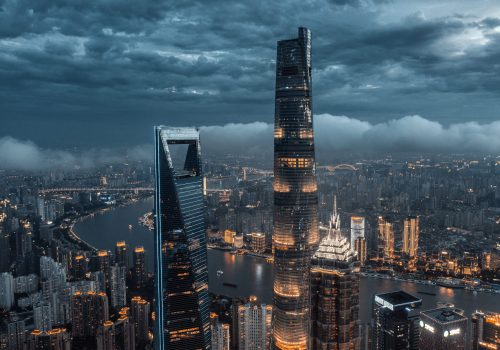Dual circulation in China: A progress report
In his opening speech at the 20th National Congress of the Chinese Communist Party (CCP), President Xi Jinping reaffirmed that “high quality development is a top priority in building a socialist modern country…achieving common prosperity…(by) implementing the dual circulation policy.” More notably, the concept of dual circulation was added to the constitution of the CCP.
Faced with a challenging international environment and hostile efforts by the United States to restrict China’s access to high technology and its products, China has adopted a dual circulation strategy to make its economy more balanced and resilient. Dual circulation means reducing the role of foreign trade in driving the Chinese economy while improving the quality of trade. This includes diversifying trade away from reliance on the United States and Europe to lessen Chinese vulnerability to political pressures from the West. At the same time, it also means improving supply chains inside China and promoting the role of private consumption and services within China’s economy to lessen its dependence on fixed asset investment, which has shown diminishing returns.
The dual circulation strategy has been formalized by consolidating various earlier policy initiatives aiming to rebalance the Chinese economy. The policy has been recommended by international financial institutions such as the International Monetary Fund and the World Bank. This piece assesses the effects of Chinese efforts over the past decade or so.
Progress can be observed more visibly in the international side of dual circulation than in the domestic sphere. However, progress seems to have stalled in recent years, complicated by the Covid-19 pandemic and China’s rigid zero-Covid policy. Both have caused significant economic disruptions, depressing growth in 2022 on top of the fallout from the debt crisis in the real property sector. Developments in the next few years will determine if the rebalancing of the Chinese economy can resume when the effects of the pandemic subside, and more importantly, if such rebalancing can generate the “quality growth” Xi Jinping is aiming for.
The international leg of dual circulation
In the international side of dual circulation, the pandemic has clouded the picture in recent years after earlier impressive progress. The share of goods traded (export plus import) to GDP, having fallen substantially from the peak of 64 percent in 2006 to the low of 34 percent in 2020, made China more open to trade than the United States (at 27.6%), but much less so than the European Union (EU—at 93.3%). However, trade share has increased to 37 percent of GDP in 2021 and remained strong so far in 2022.
By contrast, trade diversification has proceeded as planned. The volume of trade with Belt and Road Initiative (BRI) participating countries has grown significantly to reach RMB 11.6 trillion ($1.6 trillion) in 2021 (from RMB 8 trillion ($ 1.1 trillion) in 2014). This almost doubles the trade volume between China and Association of Southeast Asian Nations countries at $878 billion. These countries participate in the BRI to various degrees, so the comparison highlights the trade relationship with two overlapping blocs of countries. Most importantly, both of these relationships stand well ahead of trade with the EU at $695 billion and the United States at $657 billion. The resulting ranking of trade partners gives China some room for maneuvering in the face of economic pressures, including sanctions, from the West—by increasing trade with the rest of the world.
China has captured more value added activities through trade by increasing the share of its value added in the exports of foreign countries while reducing their value added in China’s exports—thus improving the quality of its trade with the world.
China has also taken steps to diversify the sources of supply of key inputs it needs to import—including oil, gas, and grains (buying more from allied Russia); iron ore (stepping up investment in Guinea and Cameroon), and bauxite (more investment in Guinea and Ghana). These efforts aim to lessen China’s dependence on oil from the volatile Middle East and on iron ore from Australia, which China deems politically unreliable.
The domestic leg of dual circulation
On the domestic side, the pandemic has reversed the growth of both private consumption and services as a share of GDP. From a low of 34.6 percent of GDP in 2010, private consumption has increased to a high of 39.1 percent in 2019, to fall back to 37.8 percent in 2020. It has recovered somewhat, reaching 38.5 percent in 2021, but will probably decline again in 2022 due to the aftereffects of the Omicron variant infection. The share of services in GDP has increased from 44.3 percent in 2011 to a high of 54.5 percent in 2020, to decline to 53.3 percent in 2021.
By comparison, the investment to GDP ratio has inched upward to 43 percent in 2021 from 42.9 percent in 2020. It is likely to rise again as China has stepped up fixed asset investment to support faltering growth so far this year. Over the past decade, this ratio has declined from a high of 47 percent in 2011 to a low of 42.6 percent in 2016 then fluctuating in a range of 42.6 percent and 44 percent (in 2018). Private investment has slowed a bit so far this year but still accounts for 56.9 percent of overall investment, continuing to exceed 55 percent since 2012.
While the gap in favor of investment over private consumption has narrowed from 8.4 percentage points to 4.5 percentage points over the past decade, it has become stickier in recent years. This reflects the difficulties in reversing the relative shares of GDP of these two key sectors—which is a key goal of the dual circulation strategy.
Conclusion
On balance, dual circulation represents a rational effort to rebalance the Chinese economy by reducing its reliance on net export and fixed asset investment, both of which have become unsustainable in driving growth. It has made some progress in doing so. However, it will take time—especially after the pandemic subsides—to see if and how this strategy can sustain “quality growth” for China in the face of strong international headwinds; structural impediments such as population aging and decline as well as falling productivity growth; and Xi Jinping’s emphases on securing common prosperity and ”holistic security” for the country.
Hung Tran is a nonresident senior fellow at the Atlantic Council, former executive managing director at the Institute of International Finance, and former deputy director at the International Monetary Fund.
Further reading
Mon, Oct 10, 2022
China Pathfinder: 2022 annual scorecard
Report By
Over the year, teams from the Atlantic Council and Rhodium Group have taken a dive into China’s economy to address a fundamental question: Is China becoming more or less like other open-market economies?
Mon, Oct 3, 2022
Why China’s leadership must respond to the country’s property crisis
New Atlanticist By Jeremy Mark
The country’s rapidly metastasizing property downturn threatens to engulf heavily indebted developers, homeowners, financial institutions, and local governments.
Tue, Aug 30, 2022
Deal or no deal, Chinese firms will still ditch Wall Street
New Atlanticist By Jeremy Mark
Despite a recent US-China agreement designed to end a decade-long auditing dispute, the era of Chinese firms' unfettered access to US equity markets is ending.
Image: Bridge in Hong Kong and Container Cargo freight ship


